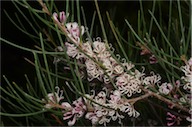Information about plants in flower this week
A news sheet prepared by a Gardens' volunteer, featuring the flowers, fruits and foliage of a selection of plants in the Australian National Botanic Gardens .
Numbers before each plant refer to temporary IFTW labels in the gardens.
Numbers in square brackets [ ] refer to garden bed Sections. Featured plants are in bold type.
View past issues of 'In Flower This Week'.
25 May - 7 June 2016
Today we will start our walk from the café then continue up the Main Path..
- On your left as you leave the cafe is Banksia spinulosa ‘Stumpy Gold [Section 131], with fine, toothed linear foliage and masses of short gold brushes with rusty red styles. This plant is a dwarf cultivar of Banksia spinulosa var. collina from material collected on the New South Wales (NSW) Central Coast.
- Also on your left is Eucalyptus gregsoniana [Section 131] with a grey trunk and white fluffy flowers. The Wolgan Snow Gum, as it is known, or Mallee Snow Gum, is found in the highlands of NSW.
- Continuing on your left is Epacris longiflora [Section 131], or Native Fuchsia with thin tubular red flowers with white tips on a small prickly bush. This plant belongs to the heath family whose native range extends from the central coast of NSW to southern Queensland.
- Further on your left is Callistemon ‘Little John’ [Section 131] a dwarf form of Callistemon viminalis. This plant shows a stunning contrast between deep red bottlebrush flowers and green/blue foliage.
- Still on your left is Epacris longiflora ‘Nectar Pink’ [Section 131], a very floriferous small shrub covered in slender pink bells with white tips.
- On your right is Correa reflexa (Kangaroo Island form) [Section 240], a long-flowering, small shrub with neat foliage and pink tubular flowers with green tips and exserted (protruding) stamens.
- Further on your right is Acacia alata var. biglandulosa [Section 240] or Winged Wattle, with flattened phyllodes and masses of white fluffy ball flowers. It is native to Western Australia (WA).
- Take the Main Path up the hill to your left, to see on your left Banksia ericifolia subsp. ericifolia [Section 30], or Heath Banksia, a long-flowering, medium-sized shrub with attractive divided foliage and long orange inflorescences. It is native to NSW, but has naturalised in small numbers in Victoria.
- Also on your left is Persoonia mollis subsp. ledifolia [Section 30] a low bush with green foliage and small, tubular yellow flowers. This plant is endemic to NSW.
- Grevillea diminuta [Section 30] on your left has hanging clusters of orange/red flowers on a neat medium-sized bush. It is native to NSW and the ACT. It was first formally described by Lawrie Johnson in 1962.
- Banksia heliantha (Dryandra Group) [Section 30], which used to be known as Oak-leaved Dryandra before the 2007 reclassification of all dryandras to banksias, is on your right. It has stiff spiky foliage and a magnificent green bud erupting from a rusty red base which becomes a yellow flower. It is native to southwestern WA near Esperance.
- Also on your right is Correa alba (pink form) [Section 30], a small upright bush with pink star flowers and grey-green foliage. It occurs naturally in sandy or rocky areas in coastal areas of south-eastern Australia
- Banksia spinulosa var. neoanglica [Section 25], or New England Banksia, is on your left, with silver backed dark green divided foliage with yellow/gold brushes held upright. This shrub grows along the east coast of Queensland and NSW.
- On your right is Buckinghamia celsissima [Section 27] or Ivory Curl, which is a small tree with fragrant dense terminal clusters of cylindrical ivory flower spikes. These trees grow naturally only in the wet tropics rainforest areas of north eastern Queensland.
- Across the road on your left is Hakea cycloptera [Section 24], or Elm-seed Hakea, with pale pink curled flowers on spiky needle-like grey foliage. It is native to South Australia. The name means circular wings and refers to the wing that surrounds the seed.
Rosalind Walcott
![Director of National Parks [logo]](../../../../images/dnp_90px.gif)







 Hakea cycloptera
Hakea cycloptera